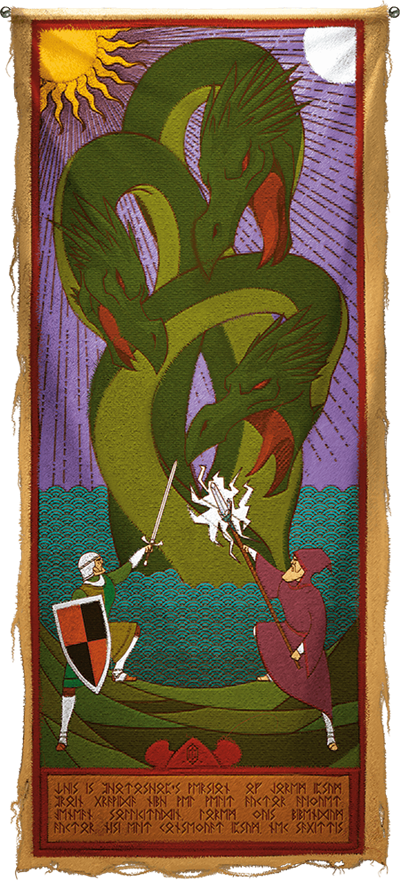 We’ve completed our second full rotation of the twelve classes in the Player’s Handbook, not to mention taken a deep dive into the first 5 levels of D&D’s thirteenth class, the inventive and arcane Artificer! This wave of the Class 101 series will appraise every subclass within the Player’s Handbook and break down each subclass’s strengths, weaknesses, thematic elements, and everything else a player would want to know before playing that subclass. Because of this, you will need to own the Player’s Handbook (or purchase the subclass a la carte on the Marketplace) in order to make full use of this series.
We’ve completed our second full rotation of the twelve classes in the Player’s Handbook, not to mention taken a deep dive into the first 5 levels of D&D’s thirteenth class, the inventive and arcane Artificer! This wave of the Class 101 series will appraise every subclass within the Player’s Handbook and break down each subclass’s strengths, weaknesses, thematic elements, and everything else a player would want to know before playing that subclass. Because of this, you will need to own the Player’s Handbook (or purchase the subclass a la carte on the Marketplace) in order to make full use of this series.
The fighter class is one of the most thematically versatile classes in Dungeons and Dragons. That is to say, while classes like paladin or warlock impose a certain level of roleplaying flavor on your character from the very beginning, a fighter is more or less a blank canvas for your own character’s story. When playing an Eldritch Knight, a type of fighter that uses weapons and destructive spells in conjunction, you’re free to determine how you gained your martial and magical skills, and what you want to achieve with them.
Check out the other guides in the Class 101 series, like the broad overview of the druid class in Fighter 101: A Beginner’s Guide to Heroic Combat, Fighter 101: Champion, and Fighter 101: Battle Master. If you’re interested in playing other classes, check out the entire Class 101 series.
Story of the Eldritch Knight
“What are you doing?” a young brother asked his sister. The sister, a fighter, knelt before a makeshift altar cobbled together by wooden boards atop two sawhorses, draped with a simple burlap cloth. A longsword rested on the altar. Her eyes were closed, and she was dressed in a simple tunic and breeches, her hair pulled into a bun. The suit of armor she had inherited from her father hung on a stand nearby. Her brow twitched with annoyance as her brother spoke.
“I’m meditating,” she grumbled. She let out a long breath and reached out into the aether once more with her consciousness, feeling for the strands of the Weave that were strung invisibly around her. She hovered her open hand over the hilt of sword, and felt new strands of magic forming between the wellspring of magic within her and the sword.
“Can I help?” her brother, bounding to her side, a huge grin on his face. “You meditating with that sword? You gonna do magic? Can I see? Can I see your magic?”
The sister scowled and growled through gritted teeth, “If you can sit still for ten minutes, yes.”
Miraculously, he was. He sat cross-legged next to his kneeling sister, alternating between gawking at the look of calm concentration on her face and the gently humming sword on the homemade dais before her. Ten tense minutes passed, and the fighter’s eyes snapped open. A flash of light glinted upon her irises, and then vanished just as quickly as it appeared. She stood and flexed her trembling hand.
“Okay,” she said to her brother, pointing to the sword. “Take it.”
“Really?” her brother gasped, eyes wide and shining with excitement.
“Yeah, really,” the fighter said, looking away. “Just watch the blade and don’t hurt yourself. Or, if you do hurt yourself, say you were playing in the forest. Mom’ll kill me otherwise.”
“Whoo hoo!” her brother whooped. He picked up the sword and swung it into the air over his head. He ran around the cellar room, slashing at invisible foes and imagining he was just like their father, killing monsters that threatened their village. His sister smiled at his excitement, then focused herself. She focused her eyes upon the hilt of the sword as her brother ran about and steadied her breathing. She tuned out all the distractions of the Material Plane and focused solely upon the strands of the Weave that bound her to the blade. She felt a surge of energy tingle from her chest down her arm, and at the moment the surge passed through her fingertips, the sword vanished from her brother’s hands.
Her brother yelped and looked around. “Ahhh! It’s gone!” he gasped. “I’m so sorry, it just—!” He turned to his sister and his jaw dropped open. Clutched in his sister’s right hand was her father’s sword. Her heart was pounding as she stared at the sword she had just magically conjured to her, but she managed to compose herself and look at her brother with a flicker of smugness.
“See?” she said. “Magic.”
Eldritch Knight Features
Eldritch Knight fighters memorize a number of destructive and protective spells during their training, in addition to other magical abilities that allow them to meld their martial and magical prowess. The fighter gains access to five subclass features at 3rd, 7th, 10th, 15th, and 18th level. You can read all of the Eldritch Knight features in the Player’s Handbook. In summary, your subclass features allow you to:
- You learn two cantrips from the wizard spell list
- You gain the ability to memorize and cast a number of abjuration and evocation spells from the wizard spell list
- You bond with your weapon, allowing you to summon it to your hand at any time
- You can make a weapon attack as a bonus action when you cast a cantrip
- Your weapon attacks make creatures less likely to succeed on saving throws against your spells
- You can teleport short distances when you use your Action Surge feature
- You can make a weapon attack as a bonus action when you cast a spell as an action
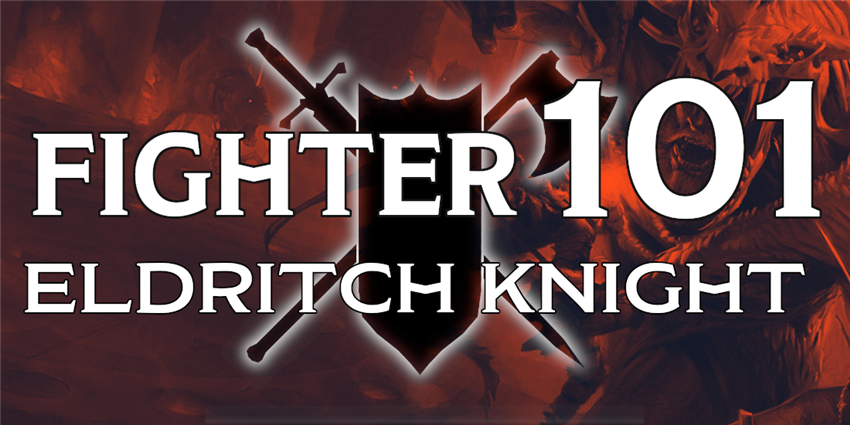
Benefits of the Eldritch Knight
There are a number of different options available for people who want to wield both spells and weapons—what does the Eldritch Knight bring to the table? The paladin offers a “jack of all trades” option by combining heavy armor and spiky damage through Divine Smite, the bardic College of Valor and clerical Light Domain provide spell-heavy options for moderately armored warriors, and the Bladesinger wizard tradition encourage lightly armored warriors to dance into battle, supported by their mighty spells.
Eldritch Knights curve in the opposite direction, using spells to complement their impressive suite of powerful defenses and overwhelming attacks. Typically, fighters can only focus on single targets with their attacks, and struggle against foes whose armor shrugs off these attacks. This encourages a very specific playstyle for Eldritch Knights: focus on spells that target multiple foes (or that effect an area), and find spells that force enemies to make a saving throw instead of requiring you to make an attack roll.
Your spells are situational tools, and the limited number of spell slots you get per day are a stark reminder of this. Don’t forget: you’re still a fighter first. Stay in the thick of combat, bashing helmets and tanking blows until your enemies have all clumped up around you, then let loose a well-timed burning hands to maximum effect. If you want to add a little more variety to your repertoire than evocation (offensive) or abjuration (defensive) spells can offer, you can add a spell from any school of magic to your list of Spells Known at 8th, 14th, and 20th level.
As you gain levels in this class, your class features will help make you more flexible. Generally, you’ll have to choose between making an attack and casting a spell on a given turn. Features like War Magic, Eldritch Strike, and Improved War Magic make this choice much less painful by letting you cast spells and make an attack in the same turn—and even giving you a benefit to doing so against the same foe.
Drawbacks of the Eldritch Knight
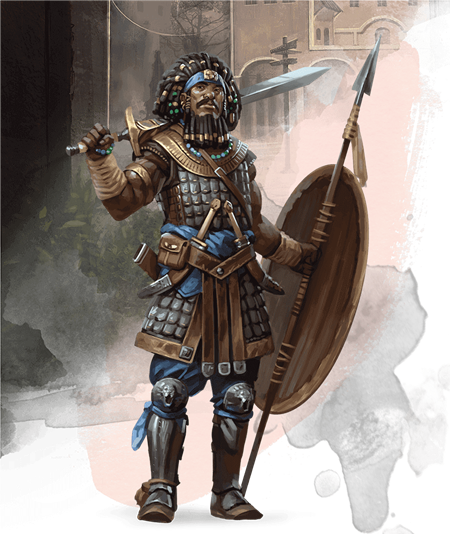 The biggest challenge of playing an Eldritch Knight is a conflict between casting spells and making attacks. These two styles of D&D combat mix like water and oil, and it’s difficult to meld them together in a way that evokes the fluid feelings of magically enhanced martial combat in popular fantasy series like Avatar: The Last Airbender or Star Wars. Casting a spell and making a weapon attack are two discrete actions; unless you’re using a purpose-made cantrip like green-flame blade, you can’t weave magic into a sword strike.
The biggest challenge of playing an Eldritch Knight is a conflict between casting spells and making attacks. These two styles of D&D combat mix like water and oil, and it’s difficult to meld them together in a way that evokes the fluid feelings of magically enhanced martial combat in popular fantasy series like Avatar: The Last Airbender or Star Wars. Casting a spell and making a weapon attack are two discrete actions; unless you’re using a purpose-made cantrip like green-flame blade, you can’t weave magic into a sword strike.
Spells that can be cast as a reaction or a bonus action, like misty step or shield, soften this issue somewhat, allowing you to make an attack and then repel your foes’ strikes with a shimmering barrier of force. Nevertheless, it can be frustrating to have to page through a list of abjuration or evocation spells with a casting time of 1 reaction or 1 bonus action to find what spells will support the character concept you have in your head.
At least that sort of research digitally is much easier than doing so with a print book, thanks to the D&D Beyond Spell tool—which, troublingly, reveal the limits of this restriction: there are only three 1-reaction-casting-time spells that fit those criteria, and no 1-bonus-action-casting-time spells. So, while the Eldritch Knight is a reasonably powerful class, the challenges of melding spellcasting and sword fighting into one fluid motion may frustrate you if you’re looking for a highly cinematic experience in your D&D game.
If you want to be able to cast spells and fight, but you’re playing a low-level one-shot or don’t think your campaign will advance past 6th level, you might be better off playing a Champion fighter and taking Magic Initiate (Wizard) feat, granting you two wizard cantrips and one 1st-level wizard spell that you can once per long rest. Your spellcasting will be much more limited than if you’d chosen to play an Eldritch Knight—at 5th level, an Eldritch Knight knows two cantrips but also knows 4 wizard spells and has three 1st-level spell slots with which to cast them. However, if giving your fighter a little bit of magical flavor is all you want, then Champion’s suite of simple, powerful combat-focused features might be more appealing.
Suggested Build
Like most classes in D&D, the fighter doesn’t choose their subclass until 3rd level. If you’re playing a fighter from 1st level and think you want to become an Eldritch Knight later, you should choose a race that improves your Strength (or Dexterity) score and also your Intelligence score. Strength affects how hard you hit with most melee weapons, whereas Dexterity makes you better with ranged or finesse weapons. Your Intelligence score affects how likely you are to hit with your spell attacks, and how high your spell save DC is, which makes it harder for foes to resist your spells. Because of this, your Strength or Dexterity score should be your highest ability score, and your Intelligence should be your second highest score.
You can play an Eldritch Knight as a heavily armored, greatsword-wielding tank, or as a lithe and nimble, rapier-wielding duelist. If you want to play the former, some good races include half-orc, dragonborn, rock gnome, and mountain dwarf. To play the latter, races like forest gnome and high elf will do the trick. Humans and half-elves are well-suited to just about any class, as well.
As usual, your character’s background is up to you. You can come up with all sorts of interesting stories and oddball characters by pairing unlikely backgrounds with the Eldritch Knight’s particular blend of sagely study and rough-edged athleticism. Were you a Sage who abandoned a rigorous regimen of “useless” magical study to practice destructive arts instead? Or were you a Noble whose tutors encouraged you to dabble in many different forms of martial artistry?
It’s a safe bet to choose EQUIPMENT when given the choice between GOLD or EQUIPMENT during character creation. The various types of equipment available to fighters easily suits either a Strength or Dexterity-focused playstyle. Choose chain mail and a martial weapon plus a shield if you want to focus on Strength, and choose leather armor, a longbow, and a rapier if you want to focus on Dexterity. Since you will gain class features that allow you to make weapon attacks as a bonus action when you cast a spell, you should focus on wielding a shield and a rapier if you want to be a Dexterity-based fighter, rather than dual wielding light weapons.
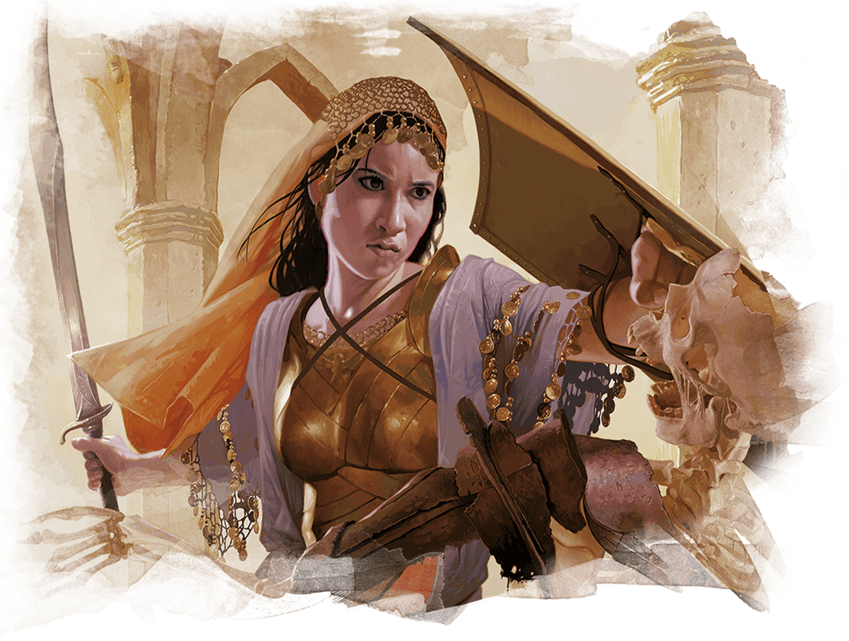
Spells
You gain the ability to cast spells when you choose this subclass at 3rd level. Your spell selection is quite limited—not only do you memorize spells instead of being able to prepare them at the start of a day, but you only have a scant two 1st-level spell slots to use. While this number increases as you level up, it encourages you to reserve your spells for big, flashy moments of destruction, or in desperate last-ditch efforts.
As a 3rd-level Eldritch Knight fighter, you know two cantrips from the wizard spell list. Since you’re likely to be in melee combat, it’s good to choose one offensive cantrip with a range of at least 60 feet to extend your reach. Your second cantrip should be either a utility cantrip to help round out your character’s skill set, or an offensive cantrip with a range of 5 feet, so that you don’t have to worry about having disadvantage when making a ranged attack while in close combat.
Also at 3rd-level, you know three spells: two 1st-level abjuration or evocation spells from the wizard spell list, and one 1st-level spell of any school from the wizard spell list. Choose these spells wisely; though you can trade out one spell you know for another when you gain a level in this class, these spells are otherwise permanent decisions. It’s wise to know at least one spell labeled OFFENSE and one labeled DEFENSE, and choose your third spell based on what you think your character would want to know. Note that this list only includes some spells from the Player's Handbook, so if you want to choose more unusual spells, or have other sources like Xanathar's Guide to Everything, you'll have to do a little self-directed research. This list is just here to get you started if this is your first time playing an Eldritch Knight.
- Alarm (SUPPORT)
- Burning hands (OFFENSE)
- Chromatic orb (OFFENSE) [be aware that you’ll have to purchase a diamond worth 50 gp in order to cast this powerful spell!]
- Magic missile (OFFENSE)
- Protection from evil and good (DEFENSE)
- Shield (DEFENSE)
- Thunderwave (OFFENSE)
Feats
As a fighter, you gain two more Ability Score Increases than any other class in the game. (The extras come at 6th and 14th level.) This means that it’s incredibly easy for you to take one or even two feats while still maxing out your vital ability scores!
Once you’ve improved your Strength or Dexterity score to 18 or 20, you can increase your power with a few useful feats. The following feats are good picks for Eldritch Knight fighters, and will improve your reliability in your own desired area of expertise:
Great Weapon Master. These days, it practically goes without saying that Great Weapon Master is one of the best feats in the game. Choosing this feat will send your damage output into the stratosphere, though only if you’re using a two-handed weapon.
Polearm Master. This feat synergizes well with War Caster and Sentinel, making it difficult for enemies to approach you or maneuver around you.
Sentinel. A must-have feat for any fighter interested in tanking for their party, Sentinel makes it hard for enemies to attack your allies, or for them to leave your reach once they’ve approached you.
Shield Master. A specialized but useful choice for Eldritch Knights who want to wield a shield rather than go for a two-handed weapon. An excellent choice for Dexterity-focused fighters wielding a rapier and a shield.
War Caster. Eldritch Knights, especially those who wield a one-handed weapon and a shield, can make use of every aspect of this feat. Making it easier to maintain concentration while taking damage is always a benefit, and not having to have a hand free to perform a spell’s somatic components is a huge boon when you can't afford to drop your shield or your rapier. Gaining the ability to make opportunity attacks with your spells is also excellent! Just imagine hurling a guaranteed-to-hit magic missile at a fleeing foe.
If you want more advice for building a fighter, check out Fighter 101. Have you ever played an Eldritch Knight fighter? What advice would you give to players that want to play this subclass? Next week, Class 101 will cover the monk's Way of Shadows archetype, an unseen ascetic who strikes from the shadows. What's your fighter character like? Let us know in the comments!
Create A Brand-New Adventurer Acquire New Powers and Adventures Browse All Your D&D Content
 James Haeck is the lead writer for D&D Beyond, the co-author of Waterdeep: Dragon Heist, Baldur's Gate: Descent into Avernus, and the Critical Role Explorer's Guide to Wildemount, a member of the Guild Adepts, and a freelance writer for Wizards of the Coast, the D&D Adventurers League, and other RPG companies. He lives in Seattle, Washington with his fiancée Hannah and their animal companions Mei and Marzipan. You can find him wasting time on Twitter at @jamesjhaeck.
James Haeck is the lead writer for D&D Beyond, the co-author of Waterdeep: Dragon Heist, Baldur's Gate: Descent into Avernus, and the Critical Role Explorer's Guide to Wildemount, a member of the Guild Adepts, and a freelance writer for Wizards of the Coast, the D&D Adventurers League, and other RPG companies. He lives in Seattle, Washington with his fiancée Hannah and their animal companions Mei and Marzipan. You can find him wasting time on Twitter at @jamesjhaeck.








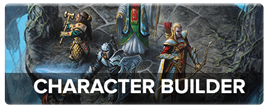
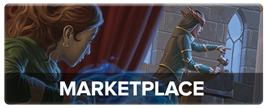
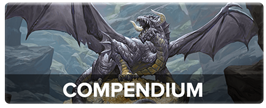
-
View User Profile
-
Send Message
Posted Sep 8, 2020Actually, for many larger shields, it’s strapped tightly to the forearm, and your hand is holding a handle. It would be easy to let go, perform the somatic ritual, then continue fighting.
-
View User Profile
-
Send Message
Posted Sep 8, 2020Yeah, but it still goes against RAW because 5E stripped out a lot of those distinctions (which is why we only have one type of shield in the game when older editions had four or sometimes more).
-
View User Profile
-
Send Message
Posted Sep 10, 2020Just wanted to mention - the article recommends picking equipment over gold at character generation, but EK is one of the few subclasses where that's arguably a BAD idea. If you know you're going to be going into EK from Fighter, then you're going to need equipment that your fighter equipment does not supply. In particular, you're likely to want a spell focus or component pouch, or, as the article mentions, you may also need non-consumed costed spell components, like chromatic orb's diamond. You aren't necessarily going to be able to guarantee that you can just pop out to the shop and buy a casting focus when you hit level 3, or that 50g diamond... So, realistically, EK is precisely one of the subclass choices where you really do want to use starting gold, rather than standard equipment.
-
View User Profile
-
Send Message
Posted Sep 10, 2020They didn't give EK smite like abilities because they wanted it to be vastly different than paladin. if you want smite abilities then you play a paladin or a war cleric. EK are designed to give a different feel where you are using magic to augment themselves or give a little bit of a mage elemental feel in key scenarios. D&D tries not to step too hard on other class abilities too much. this can leave some subclasses feeling... short... but they do try and with a feat here or multiclass there... sometimes even a homebrew rule down there. we can make things fit with the characters what we desire.
-
View User Profile
-
Send Message
Posted Sep 10, 2020If you choose gold, then the average is 120. Depending on how well you roll, you might not be able to afford everything you want or even need. Lighter armor and weapons make it a little easier, but not by much.
I also think you've overvaluing some of these items. In the PHB alone, there are four 1st level abjuration and evocation wizard spells that do not require material components: burning hands, magic missile, shield, and thunderwave. All of those are perfectly serviceable. And there are six more spell choices to round out your school-agnostic pick: charm person, detect magic, disguise self, expeditious retreat, fog cloud, and ray of sickness. They don't really need a component pouch until 7th level when they can cast 2nd level spells. And their evocation damage will always be behind full/half-casters, so spells like chromatic orb are a wasted on them. Give that diamond to someone who can make it shine.
-
View User Profile
-
Send Message
Posted Sep 10, 2020James, did you write the brother and sister story of the Eldritch Knight? I liked it. Well done!
-
View User Profile
-
Send Message
Posted Sep 10, 2020For the most part it is an even trade with the blade cantrips.
Greenflame/Booming Blade let you swing with your weapon (1 attack). War Magic nets you another attack with your bonus action (2 attacks). And the damage from the spell itself is usually worth at least 2 attacks (+1d8 at 5th, +2d8 at 11th, +3d8 at 17th), plus the added tactical advantage of your spell (damaging two enemies with greenflame blade, and punishing movement with booming blade).
Aside from the blade cantrips, True Strike actually really shines with this class because it can help you crack an enemy's extremely high AC by giving you advantage on a booming blade or green-flame blade next turn. Blade Ward lets you play as a barbarian, by giving you resistance against physical damage until your next turn
-
View User Profile
-
Send Message
Posted Sep 10, 2020Thank you! Yes, unless I cite an alternate source, all of the prose sections of Class 101 articles are written by me.
-
View User Profile
-
Send Message
Posted Sep 10, 2020Yess! I love this.
-
View User Profile
-
Send Message
Posted Sep 10, 2020I could buy that as the intention, although I still don't agree with the decision in that context. The smite spells are a very small part of the Paladin identity compared to Divine Smite, their remaining spells (like find steed) and other class features that I doubt giving them to another class would step on the Paladin's toes one bit.
-
View User Profile
-
Send Message
Posted Sep 10, 2020Yeah, the thing with Paladin smite spells is paladins hardly ever actually use them; often it's better just to Divine Smite instead. You can theoretically get more mileage out of the smite spells since they can trigger over multiple turns for a single spell slot, but Divine Smite is great for burst damage, so there's often no contest really, and it's not technically a spell which can be super handy sometimes (anti-magic field, mage with counterspell etc.).
The spells even have in-built wording that prevents them from being OP on an Eldritch Knight, as they only trigger on the first hit of each turn, so personally I'd be fine with Eldritch Knights taking them in a game, as they might actually use those spells.
-
View User Profile
-
Send Message
Posted Sep 11, 2020Actually, the smite spells only go off once during the spell's duration. Each one says "The first time you hit during the spell's duration," not "the first time you hit each round."
-
View User Profile
-
Send Message
Posted Sep 11, 2020It depends a lot on what you value and what you want to get out of your character. However, multiclassing with these two still has the same problem the eldritch knight has of spellcasting and weapon attacks mixing like oil and water, but without the benefit of recalling your weapon as a bonus action. Being a fighter that takes wizard classes is much better for getting spells, but, at that point, you have to ask yourself if you're better off just being a wizard. Honestly, the most efficient thing might be to take one level of fighter first and then go into the wizard class for every level afterward, just for the armor and shield proficiencies. Wizards don't even really have a use for action surge since you can't use it to cast spells.
-
View User Profile
-
Send Message
Posted Sep 11, 2020Just as a quick note, you can indeed use action surge to cast spells. It is the exception to the rule that you can't cast two non-cantrip spells on your turn.
-
View User Profile
-
Send Message
Posted Sep 11, 2020The rule is not that you can't cast two non-cantrip spells on your turn. The rule is very specifically that if you cast a spell as a bonus action, you can't cast another spell that turn unless unless it's a cantrip with a casting time of 1 action. Because the rule is worded so specifically this way, you can still use your action to cast a leveled spell and, for instance, use your reaction to cast a spell like counterspell on the same turn.
-
View User Profile
-
Send Message
Posted Sep 11, 2020Though in all fairness, it's a pretty ridiculous rule ^.^
It means that you can have a high level fighter-wizard cast meteor swarm, have an enemy attempt to counterspell, them, have that same wizard counterspell the enemy's counterspell, with a 7th level slot just in case, finish casting meteor swarm, then action-surge and cast an 8th level disintegrate with impunity because the other caster already used their reaction. (Net turn: Fighter-Wizard successfully cast a 9th, 8th and 7th level spell over the course of one turn)
BUT, because of the arbitrariness of that specific rule, that same wizard might first try to misty step to a better vantage point, only to have the enemy caster counterspell them.... now our high level fighter-wizard CANNOT counterspell the enemy caster - that would be casting a leveled spell on their turn after all, and they already cast a bonus action spell. So their misty step fizzles.... The wizard CANNOT try to cast either meteor swarm or disintegrate, or even a little 1st level magic missile with their action, and moreover, they CANNOT action surge in the hopes of casting at least one of those spells, because of this rule... so the wizard is forced instead to either end their turn having successfully cast nothing at all, or possibly tossing a cantrip. (Net turn: Fighter-Wizard successfully cast 0 leveled spells)
I've never seen a fair defence of this rule existing put forward that is not better answered by fixing the edge-case situation, rather than punishing all spellcasters everywhere.
(For example, the most common argument for why the listed part of your turn that it takes up shouldn't be the only limitation (like literally everything else in 5e), is cited as sorcerers chain-casting high-level spells with quicken. If you removed this rule, you'd absolutely need to tweak sorceress' quicken to only permit cantrip action casting if you quicken a leveled spell - but that would be preferable by far over pointlessly hamstringing all casters)
-
View User Profile
-
Send Message
Posted Sep 11, 2020my eldritch knight fighter was a dark elf named Carric. he walked the land in a full set of light blue plate armor, to hide his drow heritage.
-
View User Profile
-
Send Message
Posted Sep 11, 2020I don't understand why they didn't just limit quicken to cantrips in the first place. Maybe I'm missing something
-
View User Profile
-
Send Message
Posted Sep 11, 2020yes
-
View User Profile
-
Send Message
Posted Sep 12, 2020By your own words, this is an "edge-case situation" that requires a character of at-least 19th level who engaged in multiclassing (an optional rule). The rules, as written, do not need to have every edge case in mind. Such high-level characters are exceptionally powerful in the world they exist in. NPC mages only have one 5th level spell slot, and how many of them do you think there are? Priests can only cast up to 3rd level magic, and not every town or temple has one. And you want to argue about an archmage who can stop time and traverse the planes?
With all due respect, I don't think it's true that you haven't seen a "fair defense" of the rule. I just think you haven't seen a defense you've liked. Nobody's punishing spellcasters. If I didn't know better, I'd think you were just being sour that you can't let loose with all of your "cool" spells at once. Part of the fun is figuring out what you can do and when, and how a constantly-evolving battlefield can force changes.
Everyone seems to be on the same page about spiritual weapon being a good option for clerics. I wish more people thought highly of flaming sphere and Mordenkainen's sword.